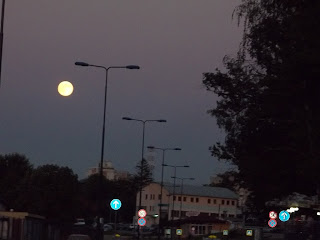On our last night in Bosnia, we drove out to the big lake west of Tuzla in Lukovac: Modračko jezero. To get there you had to pass the electric generating plant (not nuclear).
There we ate at a hotel restaurant almost alone because we were there before
sunset in the middle of Ramadan. The
flowerboxes were a riot of colors.
At anchor in the lake was a great pirate ship.
Locals out fishing in an interestingly shaped boat.
I had Bey’s chowder - served with a cornmeal muffin, pita and creamy cheese - and chicken with a lovely cream cheese sauce over
braised zucchini. Have I mentioned that aI like the cream cheese? No idea what was in the red paste sauce but it was wonderful. (actually, I just looked it up and it's called ajvar and it's made of eggplant, roasted red peppers, garlic and olive oil.)
Randy got the traditional Cevapcici (or cevaps : casing-less sausages) on flatbread with onions.
And Elder Winters got shopska salad and goulash stew baked in a
clay oven. I found out that the cheese on shopska is
Back in Tuzla we joined the rest of the
citizenry in the town square, all out for a holy day stroll and meal after sunset.
Full moon in the middle of Ramadan




Statues of Meša Selimović and Ismet Mujezinović, a poet and a painter
We met the Elders and bought them some gelato.
A photo of the Orthodox church at night














































































